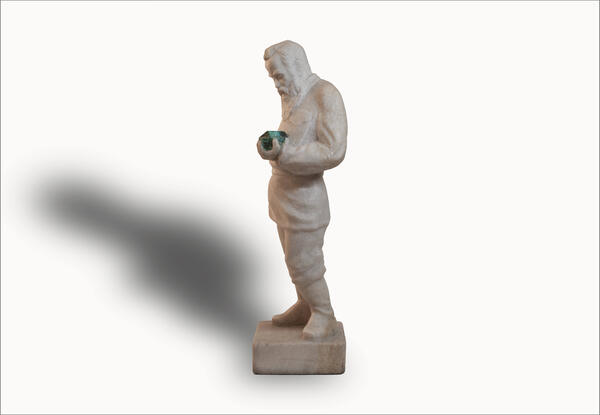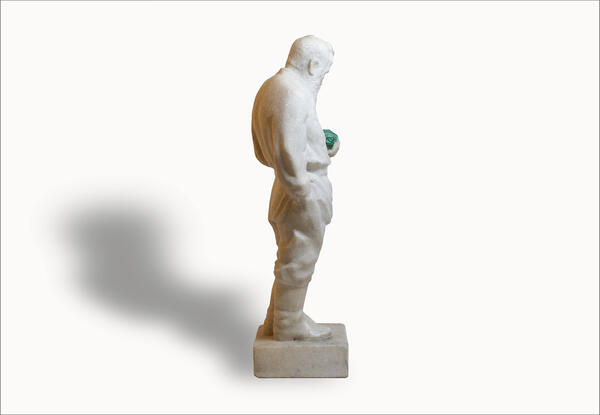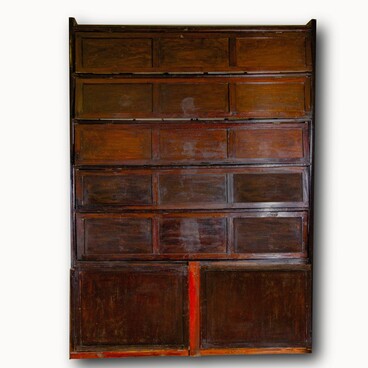The marble sculpture depicts the writer Pavel Petrovich Bazhov with a piece of malachite in his hands — a symbol of the famous Ural tales. There are two versions of the origin of this statue.
According to the first hypothesis, it was made in the 1940s either by Karp Sergeyevich Averkiev, a stone-cutter, a friend of Pavel Bazhov, or by his students from the Mramorskoye Art School, children of 13–14 years old. They created it as a birthday gift to the writer.
According to the second version, the exhibit was created by young sculptors also from the village of Mramorskoye, but under the direction of Sergey Fyodorovich Starodub. A professional stone-cutter, Starodub was born in 1915 and lived in the Russian Far East until the age of 22. In 1937, he was exiled to Kolyma as an “enemy of the people”. After he had served his sentence, he was sent to the Urals, where he became the head of the educational and production department of the Mramorskoye School and also worked as a teacher of artistic stonecutting. In the last years of his life, the master wrote several short stories and novellas, which were published in the “Novy Mir” (“New World”) magazine and published as separate editions.
It is also possible that both stonecutters worked on creating the sculpture of Bazhov, as exactly the same statue of the writer on a pedestal, although, made of soapstone, instead of marble, was found in 2020. It was broken and discovered on the premises of the Natalia Evgenievna Bobrova Center for the Development of Creativity in the town of Polevskoy. This work was restored by the team of the creative association “Diamond-Cut”, headed by Yevgeny Stanislavovich Perevozchikov.
Apart from the material, the sculptures differed in one more detail: the soapstone Bazhov holds a druse in his hands — a cluster of crystals, while the marble Bazhov holds a piece of malachite.
Some evidence suggests that a lizard made of coarse-grained marble was originally on top of the malachite stone. However, even if it was part of the original statue, it eventually was lost — even during the lifetime of Pavel Petrovich Bazhov, as the writer’s family donated the sculpture to the museum in its present form.
According to the first hypothesis, it was made in the 1940s either by Karp Sergeyevich Averkiev, a stone-cutter, a friend of Pavel Bazhov, or by his students from the Mramorskoye Art School, children of 13–14 years old. They created it as a birthday gift to the writer.
According to the second version, the exhibit was created by young sculptors also from the village of Mramorskoye, but under the direction of Sergey Fyodorovich Starodub. A professional stone-cutter, Starodub was born in 1915 and lived in the Russian Far East until the age of 22. In 1937, he was exiled to Kolyma as an “enemy of the people”. After he had served his sentence, he was sent to the Urals, where he became the head of the educational and production department of the Mramorskoye School and also worked as a teacher of artistic stonecutting. In the last years of his life, the master wrote several short stories and novellas, which were published in the “Novy Mir” (“New World”) magazine and published as separate editions.
It is also possible that both stonecutters worked on creating the sculpture of Bazhov, as exactly the same statue of the writer on a pedestal, although, made of soapstone, instead of marble, was found in 2020. It was broken and discovered on the premises of the Natalia Evgenievna Bobrova Center for the Development of Creativity in the town of Polevskoy. This work was restored by the team of the creative association “Diamond-Cut”, headed by Yevgeny Stanislavovich Perevozchikov.
Apart from the material, the sculptures differed in one more detail: the soapstone Bazhov holds a druse in his hands — a cluster of crystals, while the marble Bazhov holds a piece of malachite.
Some evidence suggests that a lizard made of coarse-grained marble was originally on top of the malachite stone. However, even if it was part of the original statue, it eventually was lost — even during the lifetime of Pavel Petrovich Bazhov, as the writer’s family donated the sculpture to the museum in its present form.





